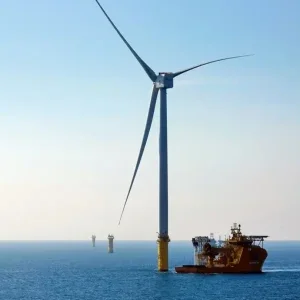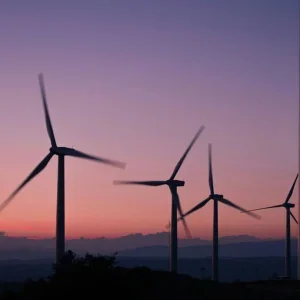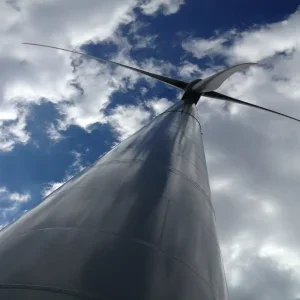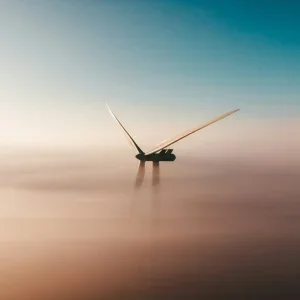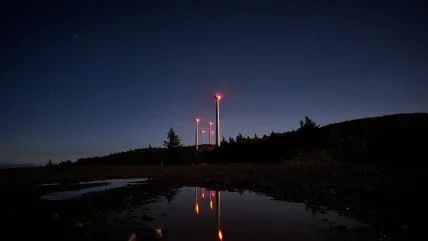
Rural Kansas should be an ideal spot for nature lovers. But visit Marshall County, amid the farms and ranches in the state’s fertile north, and you may be disappointed. With hundreds of new wind turbines sprouting up like Midwestern corn residents have begun grumbling about the blinking red lights that sit near their tops. They may be vital for preventing plane crashes – but the disco-like frequency of the flashes is proving a nightmare for people used to dark, star-filled nights. “One of the greatest things about living in rural Kansas is being able to enjoy the night sky,” complained one resident in March 2022. “The red blinking lights have taken that away from us.”
Nor are the unfortunate farmers of Marshall County alone. From the Dakotas to Germany, communities the world over have discovered that a turbine’s light systems can cause soul-crushing pollution – especially at night. Not that humans are necessarily the only ones to suffer. Some studies have suggested that the flashing lights on turbines can bewilder and threaten the local wildlife. Expensive to power and frustrating to fix, moreover, the bulbs of traditional models arguably run counter to the sustainable principles on which wind farms are designed to start with.
No wonder, then, that wind industry insiders are hunting for alternatives to the ceaseless flash of traditional turbine lights. Rather than leaving lamps to blink all night, some places are instead experimenting with so-called ‘aircraft detection lighting systems’ (ADLS) models, linking lights with aircraft radar systems so only activate when a pilot gets close. It goes without saying that this approach has the potential to leave nearby residents much happier – and save the local wildlife from some unwelcome lights. Not that this transformation is easy, requiring intense collaboration between manufacturers and government officials, ADLS can only succeed with careful management and communication. Yet, get it right and this approach could make wind energy both more sustainable and more popular, as one German company is showing.
Flash mobs
Typically soaring some 450ft into the sky, wind turbines can be a deadly hazard for low-flying aircraft. In 2014, to give just one example, a fixed-wing plane hit a turbine in rural South Dakota, killing four. In the investigation that followed, officials found that one of the disaster’s causes – apart from foggy weather and human error – may have been an “inoperative obstruction light” – which “prevented the pilot from visually identifying the wind turbine”.
It should come as no surprise that lighting turbines properly has been a fundamental tenet of the industry for years. “A legal obligation that for operation, wind turbines above a certain height must be equipped with warning lights on the turbine and, if necessary, on the tower, has existed for a very long time,” explains Jasper Salzwedel, senior sales manager at Deutsche Windtechnik, a major producer of ADLS. That’s just as true in Salzwedel’s native Germany – which mandates lights for turbines taller than 150m (492ft) – as it is in Marshall County.
In the US, meanwhile, the rules are controlled by the Federal Aviation Agency (FAA), which even details exactly what kind of lights it prefers (slower flashes promote “cleaner, crisper presentation”) and how multiple lights across a single farm should interact (synchronised flashes are best).
Yet, if adequate lighting is accepted across the wind sector, the backlash in Marshall County is far from unique either. In Germany, for instance, residents of North Frisia have long complained about the disruption caused by turbine lights – unsurprising, given that over 1,000 machines in their area have their own artificial star. A similar story could be told elsewhere, from Ontario in Canada to the French couple that won €110,000 in compensation after being subjected to ‘turbine syndrome’ from flashing lights. Nor are these objections necessarily unreasonable. Often visible for miles, especially in flat regions like Kansas, wind farm lamps can undoubtedly be an eyesore. Beyond the human cost, scientists have warned that lights can harm our animal cousins too. According to a 2018 study by the Leibniz Institute for Zoo and Wildlife Research in Berlin, hundreds of thousands – if not millions – of the creatures are lured to a blade-assisted death by turbine lights each year.
This, of course, is shadowed by more practical considerations. A constantly flashing light obviously costs money to run, while an unstinting night-time schedule means maintenance needs become more frequent too. To be fair, the industry has been conscious of these problems for a while. As Salzwedel says, the principle of airspace monitoring, which would ensure turbine bulbs only flash when needed, has been around for a “long time”. In practice, however, linking aircraft radar systems to turbine sensors has historically proved both expensive and technically complex. But as the Deutsche Windtechnik representative continues, that difficulty was overcome by instead tapping into the transponder transmissions mandatory across all aircraft. This, says Salzwedel, allows an ADLS system to be “implemented much more cost-effectively”.
You don’t have to put on the red light
If better technology is one pillar of the ADLS revolution, the law is another. In 2020, Germany became the first European country to make ADLS mandatory for a wide range of turbines in the Baltic and North Seas. After a number of revisions, wind farm operators now have until the end of 2022 to retrofit all pre-2006 turbines with hazard lights with the new system. Strikingly, Salzwedel explicitly links the move to broad unhappiness with the status quo – especially when it comes to light pollution. “Officially,” he explains, “the main reason is to increase acceptance of wind turbines in the population and promote the expansion of renewable energies.”
80k
Bats are killed by wind turbines each year in the UK alone.
University of Essex
Whatever the reasoning, the move towards ADLS is already being felt across the Federal Republic. Typical is the work at the Civic Wind Farm of Neungörs, a rural municipality north of Hamburg. At exactly 6:30pm on February 26 2021, the permanently blinking lights that had become a fixture of the area were switched off forever. Praising the ADLS that replaced them, the farm’s general manager was buoyant, noting: “The transponder-based ADLS represents an important building block for us as local operators, in that a maximum switch-off time of the obstruction warning light represents an enormous relief for both residents and the environment.” Nor is his corner of northern Schleswig-Holstein the only farm moving in this direction. Deutsche Windtechnik, for its part, is due to install 16 ADLSs at Nordergründe, an offshore facility off Bremerhaven in the North Sea.
But beyond that headline use of aircraft transponders, how does ADLS actually work? Essentially, an ADLS company first installs a transponder receiver on a turbine. Because a single receiver can control the lights of up to 64 machines, only a few are necessary across even large farms. Each of these receivers has a range of about seven miles, and is activated when an aircraft approaches, switching on the lights and alerting the pilot of the hazard ahead. When a receiver doesn’t sense an aircraft in the vicinity, it will send what Salzwedel describes as a “force light off signal” to all the turbines under its command, dampening their lights and cutting light pollution along the way. For oversight purposes, moreover, the whole process is logged remotely on a central server.
Given the sophistication of this process, it’s no wonder that ADLS require intense collaboration between manufacturers and other industry stakeholders. This is especially true, Salzwedel emphasises, with at-sea installations. “In the offshore area at Deutsche Windtechnik,” he says, “it is more the case that we offer the customer a large part of the project management and also communicate with the authorities.” Nor is that the only place where offshore ADLS differ from their landlocked counterparts. Buffered by surf, Deutsche Windtechnik ensures its sea-borne monitoring antennas are made of corrosion-resistant materials. And because maintaining offshore ADLS is so much harder than for turbines in a carrot field, Salzwedel explains that project-specific checks for offshore installations are even more vital – though adds that the ultimate differences between the two sectors aren’t huge.
A lighter touch
Despite challenges around installation, it’s clear that ADLS is here to stay – and not just for German wind operators keen to stay on the right side of the law. In a country where wind is central to the country’s energy strategy, avoiding flashing lights and keeping people on side could prove vital. That’s especially if supporters of ADLS can prove that their model protects nature in other ways too – according to that 2018 study and others, avoiding constantly flashing red lights could save up to 80,000 bats across the UK each year. The financial benefits of ADLS could be important too. Though installation is expensive, preliminary studies suggest the technology is more cost-effective than traditional red lights.
And though Germany is a pioneer in implementing ADLS, there are signs that other countries could soon follow. Responding to locals unhappy about having their night skies ruined, for instance, legislators in Kansas are looking for ways to cut blinks whenever possible. More to the point, Salzwedel argues that Germany’s example could spark broader enthusiasm for ADLS overseas. “In addition to the regulatory requirements,” he says, “the ADLS solutions are being tested on the German market for the first time, and this enables the international market to gain insights into the systems.” A fair point – and good news for long-suffering humans and bats alike.


